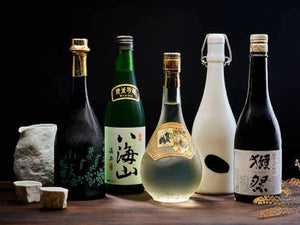
Basic Types of Sake
Understanding Sake: Rice Polishing Ratio and Distilled Alcohol
1. Rice Polishing Ratio
The rice polishing ratio significantly impacts the flavor of sake. The more the rice is polished, the cleaner the taste tends to be. Less polished rice results in a more savory and rice-like flavor, often with off-flavors.
Sake is categorized by the rice polishing ratio, which indicates how much of the rice grain remains after polishing. For example, a rice polishing ratio of 60% means 60% of the original rice grain remains. Here are the categories:
- Less than 50%: Daiginjo, Junmai Daiginjo
- Less than 60%: Ginjo, Junmai Daiginjo, Tokubetsu Junmai, Tokubetsu Honjozo
- Less than 70%: Honjozo
- Unspecified: Junmai
2. Is Distilled Alcohol Added?
Distilled alcohol may be added to sake to adjust its flavors and achieve a cleaner taste. Sake without distilled alcohol has a prefix of ‘Junmai (純米)’ before its name, which means ‘pure rice’ in Japanese. Distilled alcohol is referred to as ‘Jozo aruko-ru (醸造アルコール)’ in Japanese.
Here are the distinctions:
- Distilled alcohol NOT added: Junmai Shu (純米酒), Junmai Ginjo (純米吟醸), Junmai Daiginjo (純米大吟醸), Tokubetsu Junmai (特別純米)
- Flavor Profile: Rich, savory, grainy, rice-like taste.
- Distilled alcohol added: Ginjo (吟醸), Daiginjo (大吟醸), Honjozo (本醸造), Tokubetsu Honjozo (特別本醸造)
- Flavor Profile: Cleaner taste.
Note that adding distilled alcohol is not necessarily a negative aspect. Many award-winning sakes include distilled alcohol.

